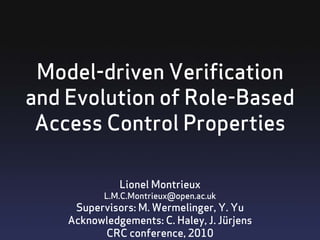Open University CRC Students conference 2010
- 1. Model-driven Verification and Evolution of Role-Based Access Control Properties Lionel Montrieux L.M.C.Montrieux@open.ac.uk Supervisors: M. Wermelinger, Y. Yu Acknowledgements: C. Haley, J. J├╝rjens CRC conference, 2010
- 5. Merging
- 7. Conclusion [YES] UMLsec model Verification [NO] Merging [YES] UMLsec model Verification [NO] OO generation Java code [YES] Choice of Java Authentication and UMLsec model Verification generation Authorization Service method framework [NO] AO generation Java and AspectJ code
- 8. Images credits ŌĆóSydney opera house model ŌĆō Peter Lindberg - CC-by ŌĆóVisa card - Declan Jewell ŌĆō CC-by ŌĆóDarwin memorial ŌĆō Stephen R. Edwards - CC-by-nc-sa ŌĆóMerge sign ŌĆō Simon Greig - CC-by-nc-sa ŌĆóBattersea power plant ŌĆō spacebahr (flickr.com) - CC-by-nc







![Conclusion
[YES]
UMLsec model Verification
[NO]
Merging
[YES]
UMLsec model Verification
[NO]
OO generation Java code
[YES]
Choice of Java Authentication and
UMLsec model Verification generation Authorization Service
method framework
[NO]
AO generation Java and AspectJ code](https://image.slidesharecdn.com/montrieux-crc2010-slides-100607095036-phpapp01/85/Open-University-CRC-Students-conference-2010-7-320.jpg)
